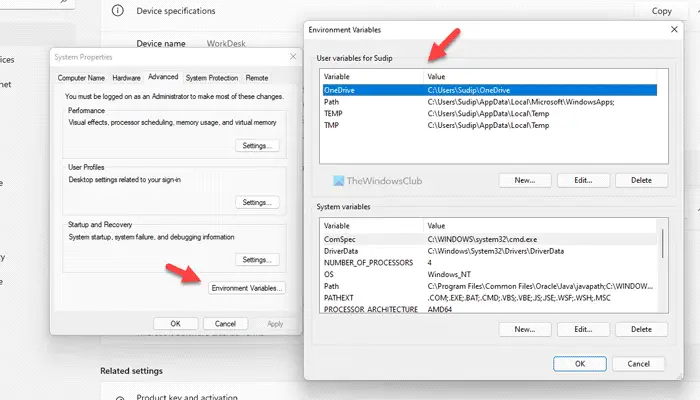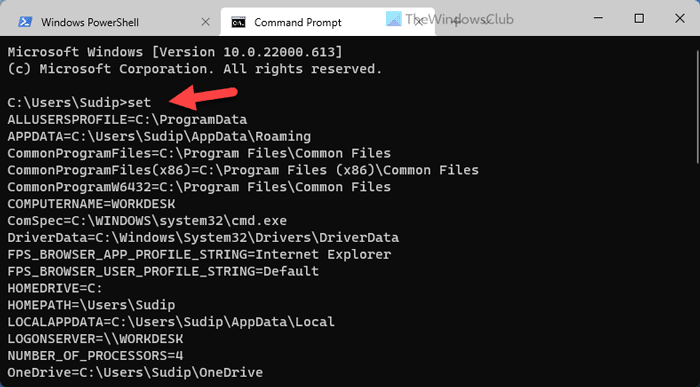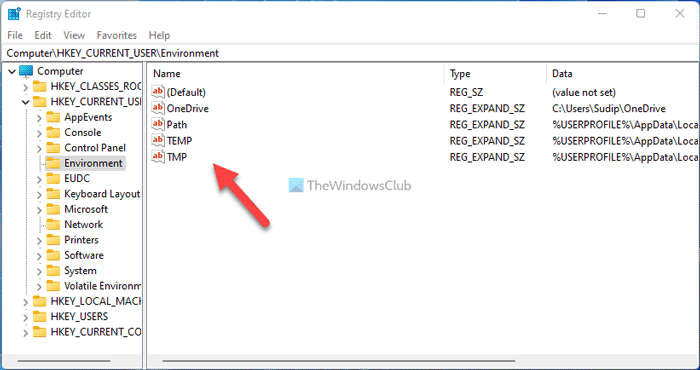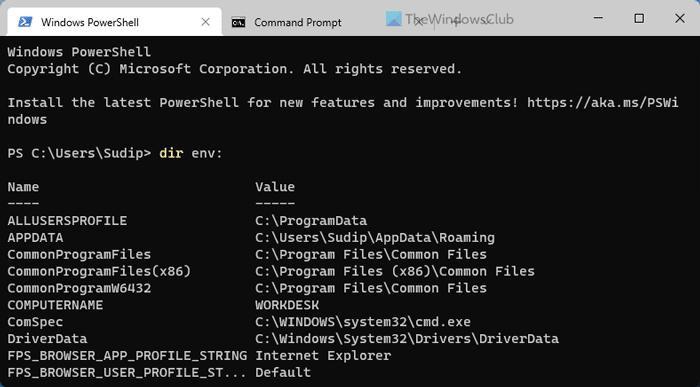If you want to see or check the names and values of Environment Variables in Windows 11 or Windows 10, here is how you can do that. There are mainly four ways to find almost everything about the Environment Variables in Windows 11/10, and this article explains all the possible methods.
What are Environment Variables in Windows 11/10
Environment Variables contain some information related to WindowsApps path, currently logged-in user’s information, Temporary folder’s path, running processes, etc. Although Windows 11/10 comes with a few of those, you can add or modify Environment Variables in Windows PC easily.
However, if you want to find those Environment Variables in Windows 11 or Windows 10, this guide will be handy for you. As said earlier, there are four ways – using the Windows Settings panel, using Command Prompt, using the Registry Editor, and using Windows PowerShell.
How to check Names and Values of Environment Variables in Windows 11/10
To see the names and values of Environment Variables in Windows 11/10, follow these methods:
- Using Windows Settings panel
- Using Command Prompt
- Using Registry Editor
- Using Windows PowerShell
To learn more about these steps, continue reading.
1] Using Windows Settings panel

It is the most common method to find the names and values of the Environment Variables in Windows 11/10 PC. Earlier, it was possible to do the same using Control Panel. However, if you are using Windows 11, there is no need to go through the Control Panel since it will eventually open the Windows Settings.
Follow these steps to find the Environment Variables:
- Press Win+I to open Windows Settings.
- Go to System > About.
- Click on the Advanced system settings.
- Click the Environment Variables button.
- Find the Environment Variables.
Next, you need to click on each variable to find the details. It displays a detailed list in the System variables box.
2] Using Command Prompt

It is probably the easiest method to find almost everything about the Environment Variables on Windows 11/10 PC. For this purpose, we are going to use the Command Prompt instance in Windows Terminal. However, you can open the standalone Command Prompt window and enter the following command:
set
In case you do not know the process to open the Windows Terminal, you can press Win+X and select the Windows Terminal from the WinX menu.
3] Using Registry Editor

If you do not want to do much with the Environment Variables and want to check them only, you can use the Registry Editor. As these variables depend on the user profile, you need to open the HKEY_CURRENT_USER. To find the names and values of the Environment Variables using Registry Editor, do the following:
- Press Win+R to open the Run prompt.
- Type regedit and hit the Enter button.
- Click on the Yes button in the UAC prompt.
- Navigate to this path: HKEY_CURRENT_USER\Environment
- Find the variables.
In case you want to modify the existing variables using Registry Editor, you need to double-click on each of them and change them according.
4] Using Windows PowerShell

Like, Command Prompt, you can use Windows PowerShell to find the same Environment Variables on your Windows 11 or Windows 10 computer. However, it displays all the Environment Variables of all the users, whereas other methods display only the current user’s variables. That being said, the list could be lengthy since it may contain some variables, such as ComSpec, LOCALAPPDATA, HOMEDRIVE, HOMEPATH, ALLUSERSPROFILE, etc.
If you are fine with the lengthy list, you can use Windows PowerShell and enter this command:
dir env:
Like the Command Prompt method, you can open the standalone Windows PowerShell or the PowerShell instance in the Windows Terminal.
How do I view Environment Variables in Windows 11?
To view the Environment Variables in Windows 11, you can use any of the aforementioned methods. If you do not want to modify existing variables, you can use the Command Prompt method. For that, you can open the Command Prompt or the Command Prompt instance in Windows Terminal and enter this command: set. Then, it displays almost everything about the current user’s Environment Variables on your screen. Similarly, you can use the Windows PowerShell method to get the same thing done. In that case, you have to use this command: dir env:
How do I get a list of Environment Variables?
To get a list of Environment Variables, you have four techniques in your hands. However, using the Windows Settings method is probably the most fruitful method since you can view, add, or modify any Environment Variable without any issue. However, if you want to get a list only, you can use any of the other three methods. To choose one, you can open the Windows Terminal and enter this command in the PowerShell instance: dir env:. If you want to use the Command Prompt instance, you need to execute this command: set.
That’s all! Hope this guide helped.
Read: How to add or edit a PATH Environment Variable in Windows.
Leave a Reply